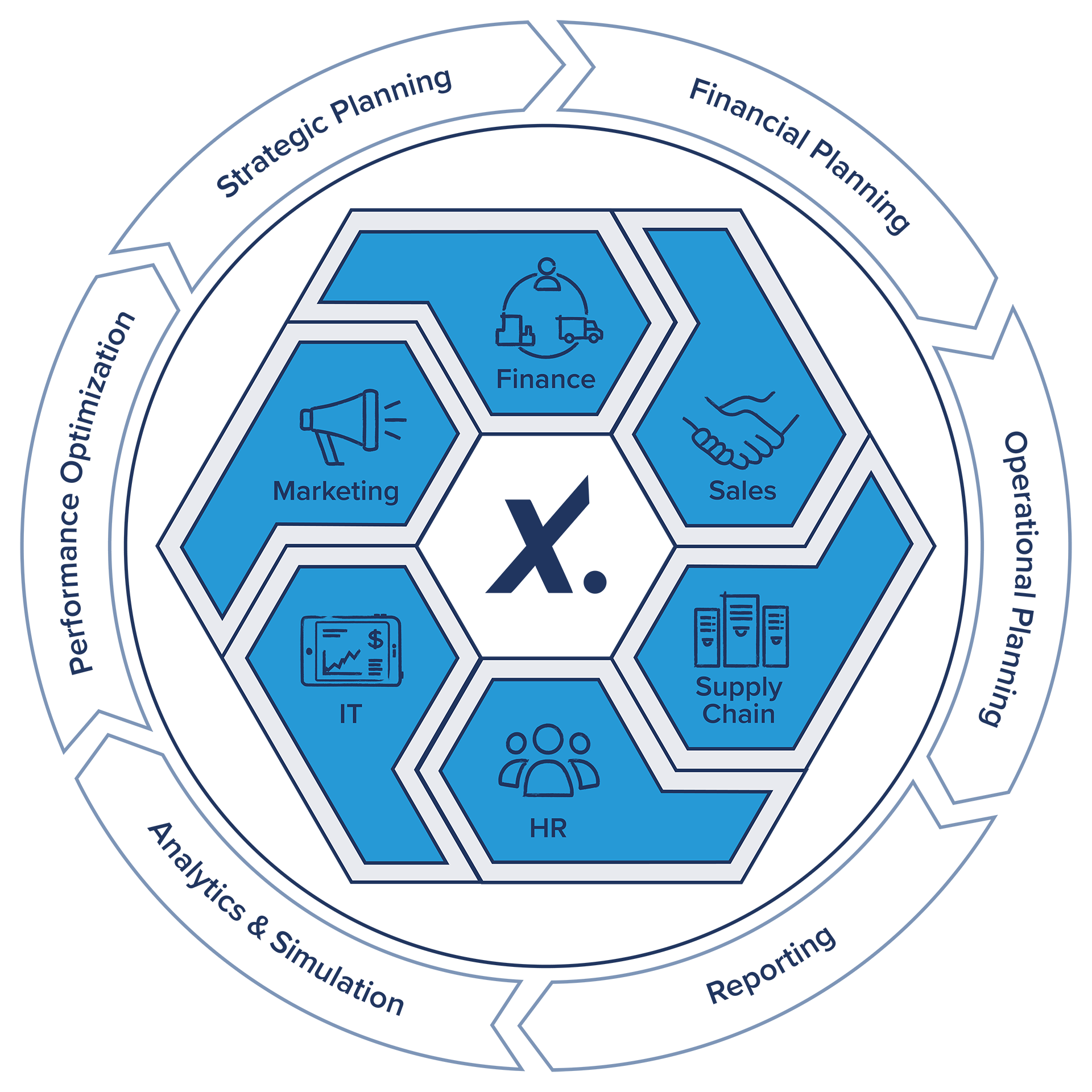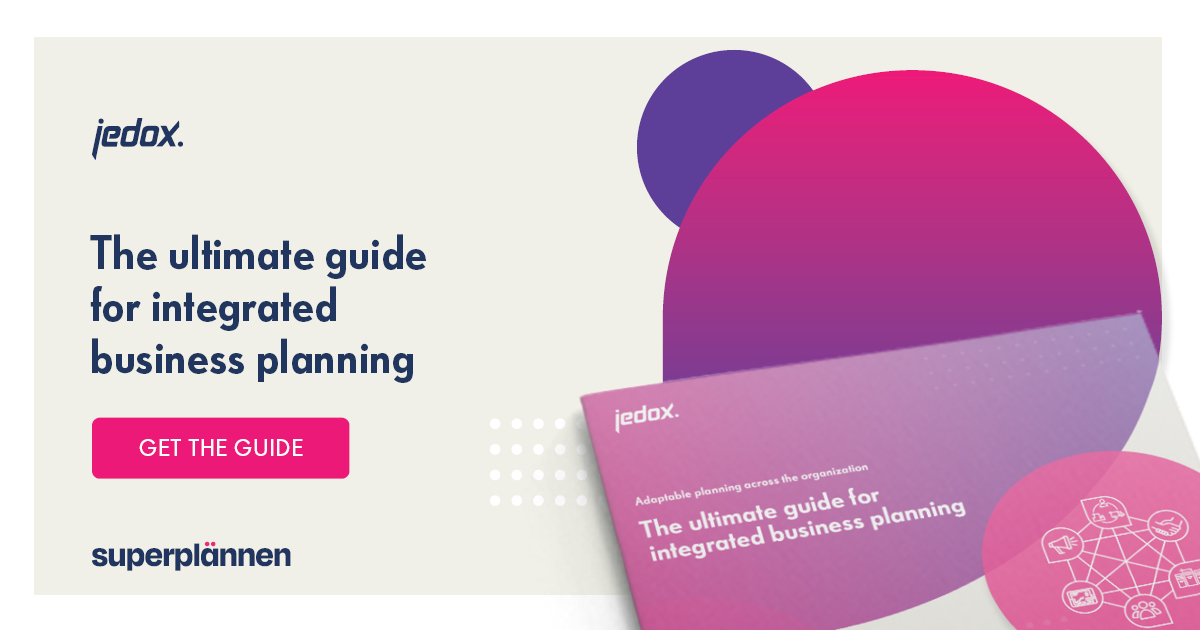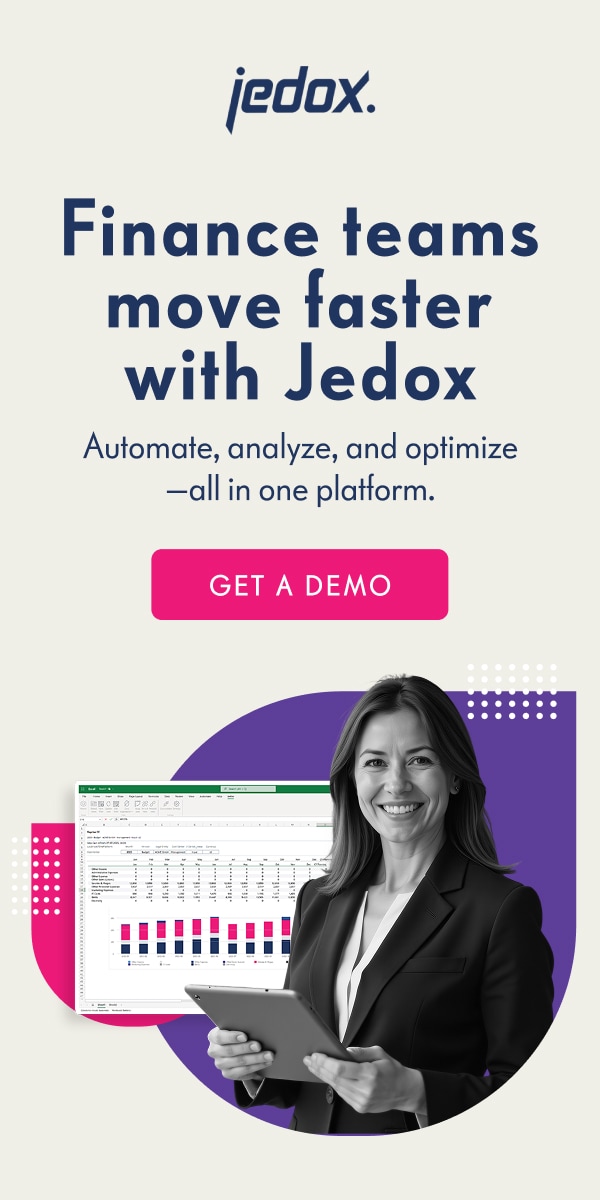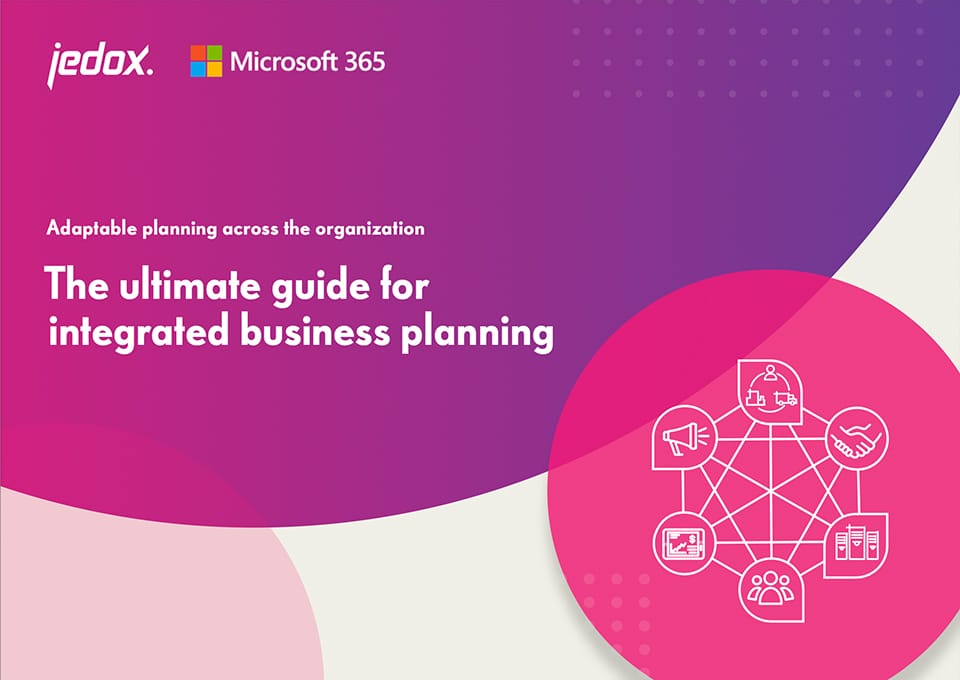
What is EPM?
- What is EPM?
- A brief history of EPM
- Is EPM a methodology or a tool?
- The scope of EPM
- Connecting the dots between EPM, ERP, and BI
- EPM today
- Optimization potential in different departments
- EPM Software
- Outlook: Proven AI solutions for modern planning
- 3 top trends in EPM in 2025
- Case studies: Jedox EPM in action
- Choosing the right EPM solution: What to consider
Planning and driving business performance has come a long way. From paper spreadsheets to advanced tech solutions, organizations have always aimed to work smarter, make faster decisions, and stay aligned with their goals. Enterprise performance management (EPM) turns these ambitions into reality.
While the methods have transformed over the years, the mission remains clear: adapt quickly, achieve lasting growth, and stay ahead of the competition.
So, what is EPM exactly? How has it evolved, and why is it so critical for the future of business?
What is EPM?
EPM is the set of business practices, processes, and tools that allow organizations to better plan and evaluate their strategic goals, including the following management processes:
- Budgeting, planning, and forecasting
- Modeling the value creation of a company
- Consolidation of the results
- Performance analysis
Key performance indicators (KPIs) such as sales, overhead, and operating costs as well as the return on investment (ROI) are generally used for planning, measuring, and analyzing performance.
There are several synonyms for enterprise performance management: Corporate performance management (CPM), business performance management (BPM), and financial planning & analysis (FP&A).

A brief history of EPM
The concept of EPM has been around for decades. Before advancements in computer and cloud technology, EPM processes and solutions were managed manually via pen and paper, long in-person meetings, phone calls, and the like.
In the 1970s and 80s, the first crude spreadsheet software tools such as Lotus 1-2-3 and VisiCalc became available, and they started to be used for accounting purposes as well as the collection of budgeting and financial information for reporting and analysis. Spreadsheets allowed Finance teams to improve budget and report creation while replacing manual worksheets.
The functionality and reach of EPM solutions started to expand following the emergence of email and other connected technologies—which in turn enabled multiple parties to collaborate on the creation of joint financial reports. This connectivity led to the establishment of more advanced software solutions for EPM. Towards the end of the 1990s, these new solutions enabled reporting and controlling automation, simplifying account consolidation efforts.
The “revolution” of EPM started during the Dot Com Era. Even though there wasn’t a true EPM technology in place yet, multiple software companies hypothesized how EPM could be designed, tailored to industry-specific needs, and used to achieve a greater degree of reporting, controlling, and analytic capabilities along with management automation.
From our perspective, the technology needed to advance this field further caught up with existing ideas around 1995 when technology-enabled benefits prompted companies to move away from paper-based practices, ditch old DOS-based systems, and embrace newer and more efficient technology.
Is EPM a methodology or a tool?
It’s important to clarify that EPM is not just software—it’s a business endeavor to seek effectiveness, as well as measure and enhance performance in your organization. It enables management to better respond to challenges as well as opportunities on project, section, operational line, geographic area, and corporate or enterprise level.
Some organizations still rely heavily on the use of Microsoft Excel for data collection and validation, as well as for their budgeting, forecasting, and reporting activities.
These processes are extremely time-consuming and error-prone, which keeps employees in a constantly reactive state—spending the bulk of their time meeting the organization’s most basic needs only. There’s no time left for value-adding activities such as monthly forecasts, what-if modeling scenarios, and building strategic partnerships.
EPM should be complemented by a robust enterprise performance management software solution, which is a crucial part of improving the EPM process and making it as efficient and effective as it can be.
The scope of EPM
In a perfect world, EPM software would manage organization-wide planning, reporting, and analysis.
Traditionally, organizations used to look at those processes as part of their “Office of the CFO” activities. With that approach, department managers from Sales, HR, and Operations had to create their own subset or personal interpretation of the financial plan.
For example, Sales managers had to take the revenue goals and split them between different revenue types: lines of business and quota carriers. HR and Operations managers had to build their capacity planning, etc. EPM bridges the gap between these different planning silos and supports planning, analysis, and reporting of business results, KPIs, and more.
You can understand this as a process:
- Collect organization-wide financial and non-financial data
- Analyze and calculate major KPIs
- Set organizational, strategic, high-level goals, and targets
- Cascade goals into functional areas of the organization
- Set targets for select business drivers
- Measure success and re-forecast
Connecting the dots between EPM, ERP, and BI
Enterprise resource planning (ERP) and customer relationship management (CRM) systems are primarily transactional systems. The primary role of these systems is to optimize and capture data from day-to-day processes and transactions to meet specific goals.
However, the name of ERP may be misleading. On the other hand, EPM systems are specifically designed to complement ERP and CRM systems.
An EPM system’s role is to provide an overview of the entire organization’s performance based on the data that was captured using these other systems in a symbiotic relationship. Additionally, in most cases, EPM allows users to update organizational planning data based on various business drivers and the calculation of business rules (e.g., discounts, allocations, growth, etc.)
Business intelligence (BI) systems offer some functionalities that can overlap with EPM systems. For example, creating an “Actual vs. Budget” report is a functionality that may be supported by both BI and EPM systems.
EPM today
Over the past couple of decades, EPM solutions have evolved from Windows-based client/server systems to Internet-enabled, web browser-based applications.
Today, there’s an increasing demand for cloud-based EPM software, also known as software as a service (SaaS). The cloud offers a more affordable alternative for EPM that lowers costs because it eliminates the need for companies to hire additional IT staff. With no costly infrastructure to support, resources can be invested in strategic growth opportunities, while employees can focus on more value-added tasks.
Over the last decade, we’ve seen the emergence of EPM solutions with incredibly complex stand-alone, modular, and cloud-based products that push the envelope of performance management. These EPM solutions are used to measure performance across all areas of the business in a consistent, efficient manner and deliver enhanced results. They also effectively link operational and business support functions together, consolidating information through financials.
EPM is more than just a system—it offers three key advantages
EPM is an organizational platform that can be used to manage and dynamically align strategic planning and goals with people and processes.
EPM systems offer the opportunity to merge silos and disconnected planning processes and allow for more flexible, accountable, and transparent performance tracking and goal setting across the organization. It does so by offering three key advantages:
- Automation of financial planning, reporting, and consolidation processes—eliminating errors and labor-intensive work
- Acceleration of cycle times, which delivers valid figures and creates more time for value-adding strategic work and analysis
- Unification of Finance and Operations according to a single plan, as integrated planning enables improved cross-departmental collaboration
Optimization potential in different departments
EPM is typically assumed to be part of Finance or Controlling. However, thanks to faster and much simpler implementation of automated planning and forecasting processes through EPM solutions, it’s also becoming instrumental for other departments. EPM software can be very useful for improving accuracy and efficiency in Sales, Human Resources, Marketing, and Procurement.
Sales teams optimize their funnel with EPM
Modern sales tools automatically generate valuable data that can be used to develop effective sales plans. These insights enable you and your team to restructure the sales funnel or optimize an existing one for better performance.
By leveraging the forecasting capabilities of a modern EPM solution, you can set measurable targets that your team monitors and refines in real time. This makes it possible to plan and manage changes to the sales funnel in a more data-driven, collaborative, and proactive way.
HR teams use EPM to better manage personnel development
The HR team identifies new requirements early on and incorporates them into their planning processes. They set clear goals and continuously compare them against real-time data streams—such as those from sales tools—to ensure alignment. This allows for up-to-date tracking of variable salary distributions with just a few clicks. Additionally, the system enables accurate forecasting to support HR budget planning.
Marketing teams use EPM to monitor campaign performance
Gain an integrated view of your marketing performance and make faster, more informed decisions about which initiatives to continue, optimize, or discontinue. With consolidated reporting, there’s no need to manually gather data from multiple sources. This streamlined approach allows you to adapt and refine existing campaigns more quickly and efficiently.
Procurement teams can better control the supply network with EPM
With an EPM solution, procurement teams gain a comprehensive overview of key metrics such as supplier capacity and product quality. This centralized visibility simplifies procurement planning, enhances transparency, and helps optimize cost structures across the organization. Teams are better equipped to respond quickly to supplier price changes, leading to cost savings and improved operational efficiency.
By integrating procurement data with financial insights, EPM transforms complex, technical information into actionable intelligence. This contextualization makes it easier for decision-makers to explain, justify, and execute strategic choices—crucial for strengthening long-term business strategy.
EPM Software
Software-supported EPM provides an important link to the next step in value creation. It looks to the future, with the capabilities of creating forecasts based on actual analyses.
Originally, EPM was only used by Finance departments, but has since expanded significantly. It’s now designed for use across numerous company functions and can be successfully implemented within the framework of integrated planning.
Applications: Modern EPM software supports functionalities across the organization and can be used as an extension tool to increase the power of business intelligence systems. EPM software provides planning, budgeting, and forecasting capabilities using dashboards to display key organizational data.
Functionality: EPM software helps companies increase efficiency by eliminating or extending spreadsheets and improving planning and reporting processes through centralized databases, workflow, and process control. This also helps increase accountability across the enterprise by aligning strategic, financial, and operational goals, expanding budgeting participants, and providing stakeholders with the latest data available with just a few clicks.
Outlook: Proven AI solutions for modern planning
In the digital age, data-based decisions are becoming increasingly important for business.
As a result, the demands on the financial sector are also changing. For Controlling, this means shifting from retrospective reporting to using predictive analytics for forward-looking insights and forecasts that are increasingly relevant for decision-making.
Another key objective is the extensive automation of routine tasks, allowing teams to focus more on strategic analysis and data interpretation. This is made possible by advanced tools in artificial intelligence (AI) and machine learning (ML). Thanks to modern cloud solutions, these capabilities are now easily accessible and supported by virtually unlimited, on-demand computing power. Jedox leverages the data hub of its EPM software platform to power AI-driven applications.
Data management and integration: The foundation for advanced analytics
A clean, comprehensive data foundation is essential for AI-powered forecasting and other advanced insights. That’s why data management and integration—core components of traditional BI environments—will continue to play a critical role in the next generation of data analytics.
Pilot projects by Jedox have demonstrated that AI-enhanced analyses within the Jedox platform can deliver business value rapidly. With more than 50 prebuilt connectors and robust ETL (Extract, Transform, Load) capabilities, the Jedox BI platform enables seamless integration of virtually any data source, regardless of volume or complexity.
3 top trends in EPM in 2025
The EPM market is on a rapid growth trajectory, expected to rise from $3.3 billion in 2023 to $4.9 billion by 2026. In 2025, AI-enhanced solutions will dominate, accounting for 40% of new implementations. Here are the top 3 trends shaping the future of EPM in 2025.
AI-driven hyperautomation
AI-driven hyperautomation is like having a smart assistant for your Finance team. It takes over repetitive tasks like reporting, reconciliations, and variance analysis—freeing up Finance teams to focus on strategic initiatives.
With natural language queries, you can ask things in plain language like, “Show Q2 revenue growth by region” and get instant results. It even generates report commentary to explain variances and anomalies, and streamlines transaction matching to boost accuracy and shorten financial close times.
Real-time data insights
In 2025, organizations succeed or fail based on their ability to access and act on instant, actionable information.
With real-time data insights, you can take control—track performance, monitor key metrics, and tackle challenges or seize opportunities the moment they arise. This consistent, up-to-date data flows across departments, keeping everyone aligned. Silos are reduced, transparency improves, and teams gain confidence knowing they have access to the latest data.
The real value lies in how companies use this data to stay ahead. Real-time monitoring of cash flow, inventory, and customer demand keeps your organization agile enough to handle whatever comes its way.
Advanced scenario modeling
To stay ahead in 2025, you need to prepare for every outcome. Scenario modeling is like having a sneak peek into the future.
Organizations can simulate market shifts, test financial impacts, and prepare for disruptions before they happen. Whether it’s evaluating supply chain risks, pricing strategies, or new competitors, you can explore “what-if” scenarios with precision.
By aligning forecasts and budgets with potential outcomes, businesses stay flexible and ready to respond to change.
Case studies: Jedox EPM in action
Don’t just take our word for it—here are the remarkable results achieved by three of our valued customers:
Gee Automotive reduces monthly consolidation process by 50%
Gee Automotive overcame the inefficiencies of Excel by implementing Jedox in their consolidation processes and forecasts. Previously, month-end consolidation from multiple dealership systems took 12 days and couldn’t keep up with the company’s rapid growth.
Jedox provided a scalable, customizable solution that retained Excel’s familiarity while addressing its limitations. This allowed Gee Automotive to eliminate manual data entry, involve more users in planning, and cut consolidation time in half to just 6 days.
VITA automates global reporting and sales forecasting
VITA Zahnfabrik, a global leader in dental manufacturing, was struggling with outdated BI systems, inefficient sales forecasting, and the need for integration with SAP S4/HANA.
Thanks to the “BI Ready to Run” modules for Jedox and SAP and their customization, the Finance team can now create a detailed sales forecasting process in just a day and a half. With the reporting portal, users can access and manage reports on their own. Automated reporting freed up 4 hours every day in the U.S., eliminating tedious manual work.
PJP achieves 3x more frequent forecasting and 10x faster scenario analysis
PJP Investments Group, managing over Papa John’s 130 restaurants, was going through a high-growth phase. As their operations scaled, relying on Excel became a challenge—inefficiencies, frequent errors, and slow data handling were holding them back.
With Jedox’s EPM solution, PJP gained centralized, controlled data access for all departments. This enabled accurate multi-scenario analysis and a shift from quarterly to monthly forecasting.
What used to take weeks now takes just days. PJP replaced manual work with consistent, error-free data reaching the precision and speed needed to support growth.
Choosing the right EPM solution: What to consider
Implementing an EPM solution that’s tailored to your organization’s specific needs takes time, and success depends heavily on open, strategic discussions with your solution provider. Key questions to explore include:
- Has the solution been carefully aligned with your organizational requirements?
- Can your team use it without needing advanced coding or programming skills?
- Are dashboards easily customizable to match your workflows?
- Is the software adaptable enough to let you build your own models?
- Does it integrate quickly and seamlessly with your existing databases?
- Does it offer industry-leading implementation timelines?
A truly modern EPM solution lays a strong foundation for enhanced agility, flexibility, and resilience—empowering your organization to respond quickly to change and drive long-term success.
How is AI impacting enterprise performance management in 2025?
AI and machine learning are transforming EPM by automating tasks like budgeting, planning, and financial consolidation, making these processes faster and more accurate. Predictive analytics powered by AI helps forecast revenue, costs, and cash flow while identifying risks and anomalies in real time. These tools help you make better decisions while giving you back valuable time for strategic priorities.
What does EPM stand for?
EPM stands for enterprise performance management. It’s a way for businesses to plan, track, and improve their performance using specialized tools and processes. EPM systems help with tasks like budgeting, forecasting, and reporting, and ensure that decisions align with the company’s goals.
ERP vs. EPM: What’s the difference?
A company uses ERP software to manage daily tasks like accounting and HR, while EPM software helps evaluate performance and plan for future success. EPM software can't capture data on its own. It relies on data from ERP, CRM, and other sources to create a deeper analysis.
What should I look for in an EPM solution?
Look for a solution that offers robust functionalities for financial planning, consolidation, and predictive analytics. Prioritize ease of use with reporting that’s simple to create and accessible on any device. Integration is key—ensure the solution connects with your ERPs and other tools while automating data updates. Finally, choose a vendor who can provide ongoing support and expertise to help you get the most out of your investment.
What’s driving the growing adoption of cloud-based EPM solutions?
Cloud-based EPM solutions are cost-effective, scalable, and easy to set up. They’re perfect for businesses of all sizes, especially as digital transformation becomes a priority. For smaller businesses, the lower upfront costs and minimal infrastructure needs make them a no-brainer. Plus, they offer real-time data access, self-running updates, and better team collaboration.
How do EPM systems integrate with existing databases and enterprise tools?
EPM systems are designed to integrate with a wide range of data sources—ERP, GL, HR, Sales, Marketing, and more. Many EPM vendors provide certified connectors, which simplify the integration process. EPM systems are independent of the underlying transaction systems. That means you can upgrade or replace your ERP or GL without interrupting essential processes like planning and reporting.
Can EPM help with ESG reporting?
Absolutely! EPM systems simplify ESG reporting by pulling together data from different sources and organizing it into one reliable framework. This framework ensures your reports are accurate, up-to-date, and aligned with standards like SASB, CSRD, GRI, and others. Plus, it helps you stay compliant with changing regulations and optimize your decisions using advanced analytics.












